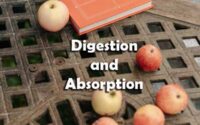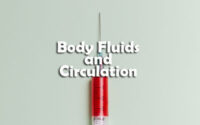Human Health and Disease
1. MALT constitute about _____________ percent of the lymphoid tissue in human body.
A. 50%
B. 20%
C. 70%
D. 10%
2. Transplantation of tissues/organs fails often due to non-acceptance by the patient’s body. Which type of immune-response is responsible for such rejections?
A. Autoimmune-response
B. Cell-mediated immune response
C. Hormonal immune response
D. Physiological immune response
3. Which cells of ‘Crypts of Lieberkuhn’ secrete antibacterial lysozyme?
A. Argentaffin cells
B. Paneth cells
C. Zymogen cells
D. Kupffer cells
4. Which of the following is correct regarding AIDS causative agent HIV?
(i) HIV is enveloped virus containing one molecule of single-stranded RNA and one molecule of reverse transcriptase.
(ii) HIV is enveloped virus that contains two identical molecules of single-stranded RNA and two molecules of reverse transcriptase.
(iii) HIV is unenveloped retrovirus.
(iv) HIV does not escape but attacks the acquired immune response.
A. (ii) & (iii)
B. (i) & (iii)
C. (ii) & (iv)
D. (i) & (iv)
5. Which of the following sets of diseases is caused by bacteria?
A. Cholera and tetanus
B. Typhoid and small pox
C. Tetanus and mumps
D. Herpes and influenza
6. Which of the following statements is not true for cancer cells in relation to mutations?
A. Mutation inhibit production of telomerase
B. Mutations in proto-oncogenes accelerate the cell cycle.
C. Mutations destroy telomerase inhibitor
D. Mutations inactivate the cell control.
7. In higher vertebrates, the immune system can distinguish self-cells and non-self. If this property is lost due to genetic abnormality and it attacks self-cells, then it leads to—
A. autoimmune disease
B. active immunity
C. allergic response
D. graft rejection
8. Antivenom injection contains preformed antibodies while polio drops that are administered into the body contain
A. attenuated pathogen
B. gamma globulin
C. harvested antibodies
D. activated pathogens
9. Assertion : IgM is a type of immunoglobulin which cannot cross the placenta.
Reason : IgM is pentamer immunoglobulin, joined by J-chain.
A. If both assertion and reason are true and reason is the correct explanation of assertion.
B. If both assertion and reason are true but reason is not the correct explanation of assertion.
C. If assertion is true but reason is false.
D. If both assertion and reason are false.
10. Short-lived immunity acquired from mother to foetus across the placenta or through mother’s milk to the infant is categorised as—
A. passive immunity
B. active immunity
C. autoimmunity
D. CMI
11. Morphine, used as an analgesic is obtained from—-
A. Erythroxylum coca
B. Atropa belladonna
C. Papaver somniferum
D. Cannabis safiva
12. A doctor identifies symptoms of nasal congestion, headache, sore throat, hoarseness, cough in a patient. The conclusion is that, the patient is infected by a pathogen-
A. Plasmodium
B. Adeno virus
C. Salmonella
D. Rhino virus
13. Some of the events occur during life cycle of Plasmodium are given below. Identify the correct statement.
A. Female mosquito take up sporozoites with blood meal.
B. The sporozites reproduce sexually in liver cells.
C. When mosquito bites a man, gametocytes are injected.
D. The gametocytes develop in RBC.
14. Identify the incorrect statement from the following.
A. B-cells produced antibody
B. Macrophages are the phagocytic cell.
C. Interferons kill viruses
D. Response of T-cells is called cell mediated
15. A person who has allergy, the type of antibody produced in his body is—
A. IgE
B. IgA
C. IgM
D. IgG
16. Assertion : Mast cells in the human body release excessive amounts of inflammatory chemicals which cause allergic reactions.
Reason : Allergens in the environment on reaching human body stimulate mast cells in certain indiviuals.
A. if both assertion and reason are true and reason is the correct explanation of assertion.
B. If both assertion and reason are true but reason is not the correct explanation of assertion.
C. If assertion is true but reason is false.
D. If both assertion and reason are false.
17. Assertion : Filarial worm is transmitted to humans by Culex mosquito.
Reason : Culex prefers to breed in freshwater.
A. If both assertion and reason are true and reason is the correct explanation of assertion.
B. if both assertion and reason are true but reason is not the correct explanation of assertion.
C. If assertion is true but reason is false.
D. If both assertion and reason are false.
18. Which of the following pathogens is not transmitted by a vector?
A. Salmonella typhi
B. AIpha virus
C. Plasmodium
D. Wuchereria bancrofti
19. Grafted kidney may be rejected in a patient due to-
A. passive immune response
B. innate immune response
C. humoral immune response
D. cell-mediated immune response
20. If you suspect major deficiency of antibodies in a person, to which of the following would you look for confirmatory evidence?
A. Haemocytes
B. Serum globulins
C. Fibrinogen in plasma
D. Serum albumins
21. Which of the following immunoglobulins does constitute the largest percentage in human milk?
A. IgG
B. IgA
C. IgM
D. IgD
22. Which of the following diseases is caused by a protozoan?
A. Babesiosis
B. Blastomycosis
C. Syphilis
D. Influenza
23. Third stage larva of Wuchereria bancrofti carried by Culex mosquito is called-
A. Cysticercus
B. Merozoite
C. Microfilariae
D. trophozoite
24. Which one of the following combinations acts as a usual antigen binding site of an antibody?
A. variable regions of a light and another heavy chain
B. variable regions of two light chains
C. variable regions of two heavy chains
D. variable regions of a heavy chain and constant region of a light chain.
25. Which one of the following is a causative agent of plague?
A. Shigella flemeri
B. Bordetella pertussis
C. Staphylococcus aureus
D. Yersinia pestis
26. Antibodies produced by a group of identical B-cells against a single epitope of an antigen are called—
A. monoclonal antibodies
B. antihapten antibodies
C. somaclonal antibodies
D. polyclonal antibodies
27. Read the statement.
(i) IgE antibodies are produced in an allergic reaction.
(ii) B-lymphocytes mediate cell mediated immunity.
(iii) The yellowish fluid colostrum has abundant lgE antibodies.
(iv) Spleen is a secondary lymphoid organ.
Of the above statements
A. (i) only is correct
B. (i) and (ii) are correct
C. (ii) and (iii) are correct
D. (i) and (iv) are correct
28. Ringworms are caused by—
I. Wuchereria
II. Microsporum
III. Haemophilus
IV. Epidermophyton
A. I and II
B. II and III
C. II and IV
D. I and IV
29. The cytokine barrier among these is—
A. Polymorphonuclear neutrophil
B. Monocyte
C. NK cell
D. Interferon
30. Which is not correct with respect to Malaria-
A. Malignant malaria is caused by Plasmodium falciparum.
B. Female Anopheles mosquito is the vector.
C. Sporozoites multiply in blood.
D. RBCs rupture and release haemizoin which causes chills.
31. Natural killer lymphocytes are an example for-
A. cytokine barrier
B. physical barrier
C. physiological barrier
D. cellular barrier
32. Which of the following best explains the difference between an epitope and an antigen?
A. An epitope is any foreign substance; an antigen is a foreign protein.
B. An epitope is the part of an antigen where an antibody or lymphocyte receptor binds.
C. An antigen is the part of an epitope where an antibody or lymphocyte receptor bind.
D. Antigens are recognised by B cells and antibodies; epitopes are regognised by T cells.
33. Which of the following antibodies is pentameric?
A. IgA
B. IgD
C. IgE
D. IgM
34. Which of the following cells secretes histamine?
A. Plasma cells
B. Mast cells
C. Monocytes
D. NK cells
35. The infective stage of malarial parasite is called-
A. Sporozoite
B. Cryptozoite
C. Trophozoite
D. merozoite
36. When are interferons secreted in the body?
A. When antibody reacts with antigen in our body.
B. When serotonin becomes active.
C. When lymphocytes become active.
D. When the cells are infected by virus.
37. The plasmodium initially multiplies within the liver cells and then attacks the red blood cells, resulting in their rupture. The rupture of RBCs is associated with release of a toxic substance—
A. Hirudin
B. Heparin
C. Heptoin
D. haemozoin
38. AIDS is caused by—
A. blood cancer
B. TMV
C. Bacterium
D. human immunodeficiency virus
39. Which type of white blood cells are concerned with the release of histamine and the natural anticoagulant heparin?
A. Monocytes
B. Neutrophils
C. Basophils
D. Eosinophis
40. World AIDS day is on—
A. May 1
B. December 1
C. December 20
D. June 1
41. The blood does not clot inside the body because of—
A. oxygenation of blood
B. movement of blood
C. presence of heparin in blood
D. absence of fibrinogen in blood
42. The letter ‘T‘ in T-lymphocyte refers to—
A. Thyroid
B. Thymus
C. Thalamus
D. tonsil
43. Which of the following is an autoimmune disease?
A. Muscular dystrophy
B. Gouty arthritis
C. Rheumatoid arthritis
D. Tay Sach’s disease
44. When a person is given pre-formed antibodies, then the type of immunity is—
A. naturally acquired passive immunity
B. naturally acquired active immunity
C. artificially acquired active immunity
D. artificially acquired passive immunity
45. Which of the following drugs acts by interfering with dopamine communication?
A. Cocaine
B. Cannabinoids
C. Opioids
D. Hallucinogens
46. Antigen binds to this part of antibody—
A. Paratope
B. Epitope
C. FC fragment
D. Fab fragment
47. Which of the following statements is correct-
A. Benign tumours show the property of metastasis
B. Heroin accelerates body functions
C. Malignant tumour exhibits metastasis
D. Patients who have undergone surgery are given cannabinoids
48. Which of the following diseases is not treated by inactivated Whole Agent Vaccine
A. Hepatitis-A
B. Bubonic plague
C. Cholera
D. Typhoid
49. Identify the set of secondary lymphoid organs from the following-
A. Bone marrow and lymph nodes
B. Spleen and bone marrow
C. Bone marrow and thymus gland
D. Spleen and lymph nodes
50. Which one is correct statement with reference to Ascaris Iumbricoides—
A. Monogenetic, dimorphic, pseudocoelomate and coelozoic parasite
B. Monogenetic, dimorphic, coelomate and histozoic parasite
C. Digenetic, dimorphic, pseudocoelomate and histozoic parasite
D. Digenetic, dimorphic, coelomate and histozoic parasite.



